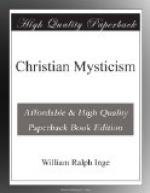The idea of man as a microcosm was developed in two ways. Plotinus said that “every man is double,” meaning that one side of his soul is in contact with the intelligible, the other with the sensible world. He is careful to explain that the doctrine of Divine Immanence does not mean that God divides Himself among the many individuals, but that they partake of Him according to their degrees of receptivity, so that each one is potentially in possession of all the fulness of God. Proclus tries to explain how this can be. “There are three sorts of Wholes—the first, anterior to the parts; the second, composed of the parts; the third, knitting into one stuff the parts and the whole.[54]” In this third sense the whole resides in the parts, as well as the parts in the whole. St. Augustine states the same doctrine in clearer language.[55] It will be seen at once how this doctrine encourages that class of Mysticism which bids us “sink into the depths of our own souls” in order to find God.
The other development of the theory that man is a microcosm is not less important and interesting. It is a favourite doctrine of the mystics that man, in his individual life, recapitulates the spiritual history of the race, in much the same way in which embryologists tell us that the unborn infant recapitulates the whole process of physical evolution. It follows that the Incarnation, the central fact of human history, must have its analogue in the experience of the individual. We shall find that this doctrine of the birth of an infant Christ in the soul is one of immense importance in the systems of Eckhart, Tauler, and our Cambridge Platonists. It is a somewhat perilous doctrine, as we shall see; but it is one which, I venture to think, has a future as well as a past, for the progress of modern science has greatly strengthened the analogies on which it rests. I shall show in my next Lecture how strongly St. Paul felt its value.
This brief introduction will, I hope, have indicated the main characteristics of mystical theology and religion. It is a type which is as repulsive to some minds as it is attractive to others. Coleridge has said that everyone is born a Platonist or an Aristotelian, and one might perhaps adapt the epigram by saying that everyone is naturally either a mystic or a legalist. The classification does, indeed, seem to correspond to a deep difference in human characters; it is doubtful whether a man could be found anywhere whom one could trust to hold the scales evenly between—let us say—Fenelon and Bossuet. The cleavage is much the same as that which causes the eternal strife between tradition and illumination, between priest and prophet, which has produced the deepest tragedies in human history, and will probably continue to do so while the world lasts. The legalist—with his conception of God as the righteous Judge dispensing rewards and punishments, the “Great Taskmaster” in whose vineyard we are ordered to labour; of the Gospel




